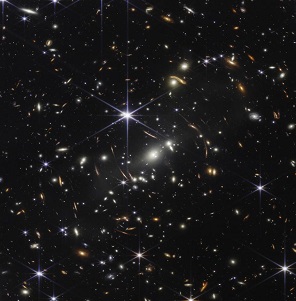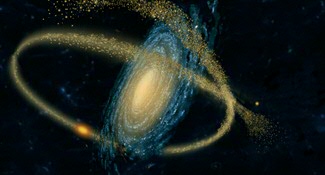Structuur, vorming en evolutie van de Melkweg
Het Kapteyn Instituut is bij onderzoek van de Melkweg altijd nauw betrokken geweest bij de studie van sterrenstelsels, te beginnen met Jacobus Kapteyn, de oprichter van het instituut, zelf. Vandaag de dag is de studie van de vorming en evolutie van sterrenstelsels nog steeds een van de belangrijkste onderzoeksthema's aan het instituut.

Belangrijke vragen
Hoe zijn sterrenstelsels ontstaan en hoe zijn ze geëvolueerd naar hun huidige staat? Als we naar veraf gelegen sterrenstelsels kijken, kijken we eigenlijk terug in de tijd. Hierdoor kunnen we sterrenstelsels onderzoeken vanaf het moment dat ze ontstonden tot vandaag. Ook kunnen we de fossielen uit de evolutionaire geschiedenis terugvinden door het huidige, lokale universum in detail te onderzoeken (de Melkweg, de Lokale Groep).
Waarnemingen van de rotatie van sterren en gas in sterrenstelsels, van de beweging van sterrenstelsels in clusters en van het heelal als geheel wijzen er allemaal op dat een aanzienlijk deel (90%) van de massa van het heelal zich in een niet-stralende vorm moet bevinden. Deze zogenoemde donkere materie wordt verondersteld in de vorm van deeltjes te zijn die nog op aarde ontdekt moeten worden.
Enkele van de belangrijkste vragen die aan de basis liggen van het onderzoek naar de structuur, vorming en evolutie van sterrenstelsels zijn:
-
Hoe vormen sterrenstelsels zich tijdens de vroegste fasen van het heelal?
-
Hoe evolueren sterrenstelsels in de loop van de kosmische tijd en vormen ze de reeks van soorten stelsels die we nu waarnemen?
-
Wat is de rol van donkere materie en (HI) gas in de vorming van sterrenstelsels?

Projecten
Enkele projecten, programma's en instrumenten op het gebied van melkwegonderzoek waar het instituut bij betrokken is:
-
De studie van high-z galaxies met de JWST, HST, VLT, ALMA en andere instrumenten van wereldklasse.
-
De studie van de dynamica van ons Melkwegstelsel en andere sterrenstelsels met bijvoorbeeld Gaia, WEAVE
-
De Fornax Deep Survey
-
De XSL stellar library
-
De studie van zwakke en sterke gravitational lensing met bijvoorbeeld VST-KiDS, HST, Keck, ALMA en Euclid.
-
De studie van HI in sterrenstelsels met bijvoorbeeld APERTIF, MeerKAT, SKA
-
Onderzoek van de voorgrond van de Melkweg met LOFAR

Toekomstig onderzoek
De toekomst van het onderzoek naar de evolutie van de Melkweg aan het Kapteyn Instituut is gebaseerd op de wetenschappelijke exploitatie van nieuwe faciliteiten die dit decennium beschikbaar komen, maar ook op het kapitaliseren van huidige ontwikkelingen, zoals de studies van het Epoch of Reionization met LOFAR en APERTIF HI studies.
De astronomen van Kapteyn zijn sterk betrokken bij JWST, met name via de MIRI European Guaranteed Time, waarmee ze de evolutie van melkwegstelsels vanaf het allervroegste begin van de kosmische tijd kunnen bestuderen. Deze analyses zullen worden aangevuld met studies naar melkwegstelsels met een groter oppervlak met Euclid, die in 2023 is gelanceerd.
Daarnaast zullen verdere projecten naar de fysica van de vorming van sterrenstelsels vanaf het tijdperk van reïonisatie tot het lokale heelal worden uitgevoerd met behulp van faciliteiten op de grond, zoals WEAVE/WHT en verschillende instrumenten (MICADO, MOSAIC) op de E-ELT.
Wetenschappelijk medewerkers
Wetenschappelijk medewerkers die op dit gebied werken, zijn: Caputi, Helmi, Fraternali, Koopmans, McKean, Peletier, Rizzo, Starkenburg, Tolstoy, Trager, Verheijen, Wang, van de Weijgaert.
